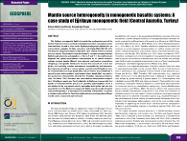Mantle source heterogeneity in monogenetic basaltic systems: A case study of Egrikuyu monogenetic field [Central Anatolia, Turkey]
Özet
The Egrikuyu monogenetic field is located in the southwestern part of the Central Anatolian volcanic province and includes numerous scoria cones and related lava flows, as well as a few maars. Egrikuyu monogenetic field basalts are mainly olivine-nepheline (Ol-Nph) normative, with higher MgO (79-11.5 wt%) and Ni (up to 226 ppm) contents compared to other Central Anatolian volcanic province basalts. Enrichment in large ion lithophile elements compared to high field strength elements and depletions in Nb, Ta, P, and Ti in the multi-element diagrams are typical trace-element characteristics of all Central Anatolian volcanic province basalts. Mineral, trace element, and isotope compositions of Egrikuyu monogenetic field basalts revealed the necessity of at least two distinct and variously enriched components responsible for their formation. Decompressional melting of metasomatized subcontinental lithospheric mantle (enriched mid-ocean-ridge basalt-like), with or without the contribution of upwelling deep asthenospheric melt (oceanic-island basalt-like), may explain the geochemical characteristics of all Central Anatolian volcanic province basalts. The lower( 207)Pb/Pb-204 ratios and some distinct clinopyroxene compositions (titaniferous augite and Fe-rich diopside) in Egrikuyu monogenetic field basalts are indicators for the presence of upwelling asthenosphere, which is also evident in the low-seismic-velocity anomalies and Cyprian slab tear that underlie the field. The Egrikuyu monogenetic field is a good example of mantle source heterogeneity in a monogenetic basaltic field and therefore constitutes a suitable region within the Central Anatolian volcanic province where different mantle source components can be traced.


















